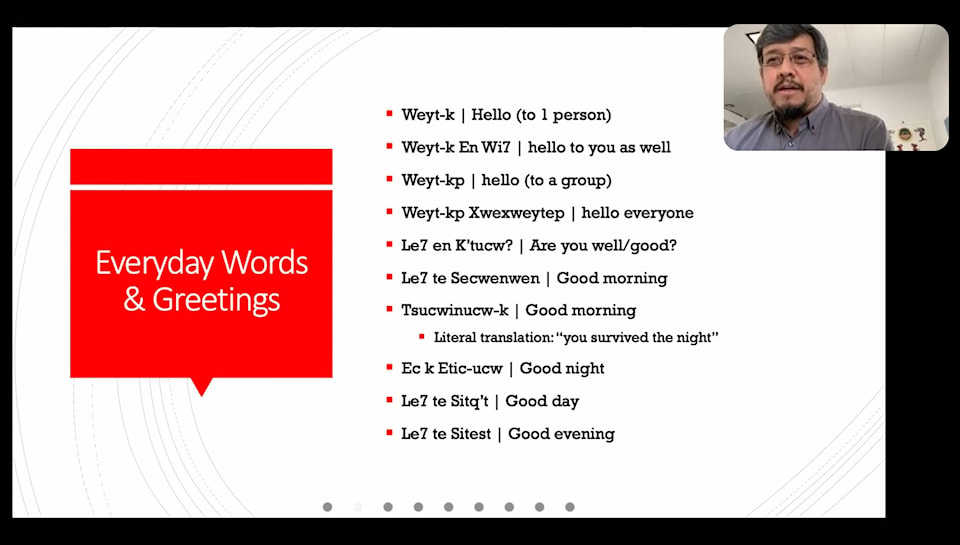It’s hard enough to say Secwepemc, let alone Weyt-k or Kukwstsetsemc.
But the facilitator of an online workshop teaching basic Secwepemc phrases is pleased that so many are willing to try. Twenty-eight people attended a virtual session from all over the province last week to learn phrases such as “Weyt-k” (hello), “Le7 en K’tucw” (are you well?) and “Kukwstsetsemc” (thank you).
“I was blown away by the number of people who registered,” said Murray Casey, president of the Stemete7uw’i Friendship Centre. “That was really nice. I didn’t know how it was going to turn out, having it online.”
The hour-long workshop started with a southern Shuswap drum song, as well as an introduction and prayer.
After a brief history of the Secwepemc people in the region, participants had the chance to try speaking some common phrases, soon realizing there is nothing simple about the language.
As none of the words are pronounced the way they are written, participants often stumbled when following along with written slides. When Casey asked for a volunteer to try saying “Weyt-kp Xwexweytep” – which translates to “hello everyone” – there was a long pause, followed by nervous laughter before a participant gave it an apprehensive shot.
Once Casey slowly enunciated the phrase – and participants repeated it back a handful of times – confidence began to improve, along with the accuracy.
READ MORE: Secwepemc Nation raises spirits through song
“I would say it’s a really difficult language, so I try to keep it as simple as possible,” Casey said after the workshop. “They say if you can speak German then you can actually pick up the Shuswap language.”
The language has 43 consonants and five vowels, and many of the sounds don’t have an English-language equivalent, which makes pronouncing the words and phrases even more challenging.
“There’s no rhyme or reason for a sound that the letters are making in the Shuswap language,” Casey said. “You have to be so careful how you say these words – one little twist in the word can have a whole different meaning.”
For example, Casey said “Sqéxe” in western and northern dialect (found in western Kamloops and north of 100 Mile House and Williams Lake) means “dog,” whereas in the eastern dialect (Chase and Enderby regions), “Sqéxe” means “horse.”
Secwepemctsin was a strictly spoken language until the late 1970s when Dutch linguist Aert Kuipers came to the region and worked with the local Indigenous communities to create a dictionary.
“The elders at that time were trying to get the language out there,” Casey explained. “It was a huge thing for (Kuipers). Getting it down on paper was one of the ways to help carry it on.”
Teaching the language is something Casey has always been passionate about, having learned the basics from his mom and grampa as a kid. Inspired to expand his knowledge, he studied online as well as at SFU in Kamloops where he eventually started a 10-year teaching career.
Casey said it takes new learners quite a while to become fluent, mainly because of the declining interest in learning the language, something he said he hopes to change.
“For me, it’s important that we have the language moving forward,” Casey said. “It gives people the opportunity to learn a language they wouldn’t normally have. We’ve lost so many of our elders who speak the language, it’s hard to find anybody to speak it with.”
He estimates there are only about a dozen or so fluent Secwepemctsin speakers in the entire Cariboo region.
Casey said he hopes to continue offering online workshops and will explore the possibility of weekly sessions; updates about future classes will be posted on the Stemete7uw’i Friendship Centre Facebook page.
